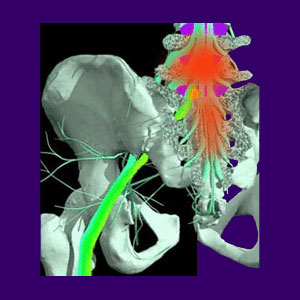
A discogram is a specialized diagnostic test that is performed to implicate or acquit a particular intervertebral spacer in the causation of a back or neck pain complaint. The procedure is also known as discography, disc pressurization or minimally invasive disc pain evaluation.
Discography remains one of the most controversial of all tests, since it certainly does not have the ability to definitively diagnose any cause of pain in most patients and actually creates many false positive results that eventually cause the patient to undergo unneeded and ineffective surgical treatment. Furthermore, the procedure can be terribly painful and has serious inherent risk factors to consider. Regardless, discography remains a mainstay of back and neck pain diagnostic evaluation.
This essay explores discography within the dorsalgia diagnosis community. We will provide dialog on the positive characteristics of invasive disc evaluation, as well as detail the overwhelming negative attributes of this often misguided test.
What is a Discogram and Why is it Used?
Discography is not a back or neck pain care practice. Instead, it is a diagnostic test that is theorized to be able to help pinpoint the actual location of pain that is suspected to be caused by an intervertebral disc in the backbone.
Discography is typically used when a herniated or degenerated disc is suspected of being the source of pain, but when no definitive mechanism can be easily identified to explain the symptomatic expression. Discography is generally ordered when the diagnostician is evaluating the patient for more drastic treatment of back or neck symptoms that have not responded to conservative care. However, sometimes, discography is prescribed early on in the diagnostic process, occasionally before any therapies have even been attempted.
The test seeks to single out painful discs from non-painful intervertebral tissues, through the process of pressurization via fluid injection. The theory states that adding pressure to the interior of the disc will increase subsequent pressure that may be applied to nerve tissues, therefore generating the type of pain that is demonstrated in the patient complaint. This is applicable regardless of whether the disc is theorized to be causing a compressive neuropathy of a specific nerve root, cauda equina syndrome or central spinal stenosis.
Additionally, injections will help the diagnostician to visualize the disc internally, allowing them to determine if an annular tear exists and possibly, if chemical nerve irritation might be the mechanism for pain.
Discography Technique
Discography is a short-duration outpatient procedure that requires the recipient to remain awake and responsive to the stimuli experienced at the various injection sites. The patient will usually receive oral, followed by intravenous, antibiotics before the procedure, in order to reduce the chances of suffering what might become a dire infection of the spinal structures.
Depending on the exact nature of the pain, and the specific reasons for performing the test, the patient might endure x-ray guided injections directly into several spinal discs. Once the needles are in place, the physician will inject fluid and contrast dye into each disc that is thought to be involved in the painful complaint.
The fluid will swell the disc nucleus, increasing mass and internal pressure in the intervertebral structures. The patient will be asked to provide feedback on the experience, as each injection is received. They will be instructed to inform the doctor if they feel pain, pressure or nothing at all. If pain is perceived, they will be asked to determine if the symptom mimics their usual discomfort or seems to be unrelated in location or expression.
Typically, x-ray or CT scan will also be used to visualize the path of the injected fluid, so as to ascertain if there are any leaks from the disc due to annular tear or a fully ruptured disc condition.
The injection sites typically do not require any special aftercare or sutures, but the patient will be advised to relax and not to perform any strenuous activities for a few days.
Discogram Risks and Rewards
While the theory behind discogram testing seems sound and even enlightened to laymen, the reality of the test has some truly dark aspects to consider.
First off, many patients find the test to be horribly painful and are traumatized from the procedure. A few patients claim that their overall pain worsened dramatically post-discography testing and never let up.
Next, there are significant risks that are inherent to discography, including spinal fluid leaks, spinal nerve damage and the risk of discal infection. This last possible consequence can spell disaster and might require invasive treatment in rare instances.
Discography does not prove anything more than the simple fact that adding pressure to virtually any compromised disc will cause pain. It certainly does not often successfully pinpoint the existing painful complaint.
Remember, the very reason the test is most often used is because several discs are often implicated in causing the pain, but none are conclusive. If 3 to 4 intervertebral structures might be involved, then adding this kind of stress to any of them is likely to elicit some degree of pain. This explains why so many patients receive results that multiple discs are the true causation, often moving them from discectomy candidates to spinal fusion candidates. This is the proverbial “out of the frying pain and into the fire”, in terms of devastating treatment recommendations.
Furthermore, discograms are used to justify surgery in many cases, but the results of said procedures are no better than surgeries that are performed without the benefit of discography testing. In essence, discography is not any more successful in placing the patient on an effectual course of therapy.
It should be noted that discography is highly profitable for physicians, so it is often used as a great way to add value to the diagnostic process for cases of intractable back or neck pain. Most doctors do not take the risks too seriously and feel the test is worth their financial gain, even if it does not add much value to the patient’s treatment prospects.
Objectively, the test can be useful in diagnosing annular tears and even placing blame on some pathological degeneration or intervertebral herniation conditions. However, these successful applications are in the statistical minority of patient citations. In most cases, discography proves nothing, costs money and involves sizeable discomfort, with the only benefit being the increased billing amounts for the doctor.
No wonder discogram evaluation remains one of the most hotly-debated tests within the back and neck pain arena, with recipients often regretting their decision to undergo the procedure due to pain, inconclusive results or post-test pressure to move directly into drastic and mostly ineffective surgical “correction”.





